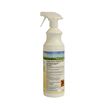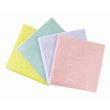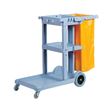Cleaning the kitchen
Kitchens are germy places and according to studies, need acquainting with your cleaning supplies!
Kitchens can be the most germy places harbouring hundreds of thousands of bacteria per square inch including pathogens like Salmonella and E-Coli. In order to reduce the bug count in our kitchens it is essential that we carry out regular effective cleaning with the appropriate cleaning supplies.
The average kitchen sink may contain upto 500,000 bacteria per square inch and thats just in the drain alone, simular bug counts have been identified in sponges, basins, tap handles and plugs. Our kitchens are dirtier than our bathrooms.

One reason for this is the fact that there is so much for the germs to thrive on, raw meats, fruit and vegetables, milk, tea, coffee spills, sugars the list goes on. The bacteria found within all the food stuffs it literally transferred all around the kitchen when we are cooking or preparing food.
You may have noticed at christmas on the turkeys cooking instructions, there may have been advice "not to rinse" the turkey as part of your preparation before cooking. The reason for this is when you take the turkey hold it over your kitchen sink, turn on the tap to rinse, any bacteria in now in the sink and on the taps.
You probably then held the turkey over your work surfaces where excess water may have dribbled, probably some went on the floor too, its on your hands now so when the turkey went in the oven any contamination is on the oven handle and knobs. From there is likely spread to the exterior and interior of the fridge, microwave, light switches, door handles, kitchen table...wow you have most likely contaminated the whole kitchen with a harmful bacteria and its christmas!
Ever likely they say dont bother to rinse the turkey...the heat of the oven would kill the bacteria anyway.
Thats how easy germs can be transferred via hand carriage. If we are using our cleaning supplies and in particular our bactericidal cleaning products correctly and regularly, these harmful germs would be drastically reduced, there would be far less bio nutrient for them to live on.
So we can look at steps to take to maintain a clean and tidy kitchen but a very simple way to cut cross contamination is to ensure we wash our hands and wash them well with warm soapy water for at leist 20 seconds. We have a great range of hand soaps and sanitising gels which are independantly tested by the british analytical board for their germ killing abilities.
Cleaning tips and cleaning supplies for your kitchen
Take a look at your kitchen and remove any clutter and items which should be in other rooms. These items will be gathering dust and cluttering your surfaces making cleaning your surfaces an awkward job to carry out.
Find homes for any appliances or utensils that may be lying around, again this will free up surface space and make cleaning easier. Before you put items away be sure to use a suitable cleaning product to clean and disinfect them before storing.
Check out your window ledges, is this really the right home for those little ornaments, momentos from holidays, kids paint brushes etc. Possibly these items have been there for some time, maybe its time for a little recycling or re-housing, you will be able to keep these ledges much cleaner if you do away with the junk.
Now the floors, a very germy place. Look at any clutter and ask yourself how long its been there and when you last picked it up to use. Anything that you havent needed for a long time should put back in its place or found a place or if you dont need it, or maybe moved altogether, be a little ruthless if you can! Remember clutter collects dirt, food debris, hair, grease and grime providing an environment germs will love.
Take down any curtains, nets or blinds and give them a wash or a wipe down.
With your duster dust any cobwebs from the ceilings or walls.
Clean your oven and extractor fan first as this is probably quite an dirty job. Choose a good degreaser and spray it on the interior and exterior of the over, allow some contact time for your cleaning product to work, agitate with a sponge scourer and wipe away with a wet cloth. You may need to repeat this process especially if you have a lot of food spills or charred on debris.
For your extractor fan remove the filters and wipe down with a good degreaser, again if necessary repeat this process.
Ideally you should be cleaning your oven each time its used, it would then be a quick and easy clean as there wouldnt be a greasy, charred on build up to remove.
A handy tip for your frying pans or casserole dishes is to leave them on the hob after use with hot soapy water, once this has boiled up you will find that your pans and dishes need little cleaning and you will have saved yourself a grimey job.
You should wipe down your cupboards ideally every few weeks, make sure you keep a good bactericidal cleaner and degreaser in your cleaning supplies cupboard, spray the cleaning product onto your cloth or directly onto the surface to be cleaned and clean away any grime or dust. Areas around the oven and hob may need a more thorough clean as they will be greasier.
Now deal with the fridge and microwave, wipe down the exterior, keypads and handles and then the interior, with the fridge you will need to empty the contents and carry out a thorough clean. We have a section dedicated to cleaning the refrigerator.
Dont forget the kitchen table, give it a good wipe down including the edges where children cling to with foody fingers and chairs shouldnt be forgotten either as they represent a big hand contact area. Again use a bactericidal cleaner.
Salt and pepper shakers are big hand contact area and thus germ transfer point. A report in the U.S by the University of Virginia looked at 30 people who were starting to show signs of a cold. They were asked to list ten areas which they knew they had touched in the previous 18 hours, the researchers then tested these areas looking for the cold virus. The virus showed up on 41% of the surfaces tested but where people had said they touched the salt and pepper shakers there was a 100% occurence of the virus.
Empty and clean your bin, use your cleaning product the clean the exterior of the bin, again bins can harbour many bacteria especially those without a foot lever to open the lid, so be sure to carry out a thorough clean.
We are onto the really germy bit now your kitchen sink, remove any dishes, pots pans etc. If your sponges or cleaning cloths are looking a little tired throw them out and replace with new. If they arent that worn you could put them through the dishwasher or leave them to soak in a solution of bleach.
Once your sink is decluttered you will need to use your cleaning supplies again, spray your bactericidal cleaner all over the sink, including the drainer, taps, back of taps, overflow, plug area and the basin. Use a sponge scourer to really scrub away any food debris which maybe stuck to the sides, rinse away and repeat the process.
Remember that you cant sanitise a surface if your sanitising product hasnt contacted with it, so give a final spray around with your bactericidal cleaner once you are sure all the food, dirt, grease and grime has been fully removed from the surfaces you are cleaning. Allow contact time for the bactericide to do its job and rinse away.
Its time to tackle those work surfaces which you have already decluttered. Using a clean cleaning cloth (you dont want to ruin your hard work by using a germy cloth here) spray your bactericidal cleaning product over your surfaces and work in with your cleaning cloth, remove any food debris, dust, food spills and soils and repeat as necessary, be sure to keep rinsing your cloth out and once the surfae are looking clean do a final spray of your bactericidal cleaning product, allow contact time to ensure a good bug kill and wipe away with your cleaning cloth.
If you want to you could use a clean tea towel to dry your surfaces.
Okay so your kitchen is looking pretty clean and sparkling and your almost done, just the floor to clean now. Start by brushing up all the dust and bits that have collected, use your hand brush to dust the skirting boards and give them a wipe over with your bactericidal cleaner.
Using a solution of your cleaning product mop the floor starting with the furthest point away, work your way back to the door and when you have finished allow the floor time to dry.
If the floors pretty dirty use a stronger solution and really work the product in, you might want to allow some contact time and then come back and mop over the floor again. If so give a final mop with warm water, this is always a good tip as it removes the last of the dirt along with any residue of cleaning product.









